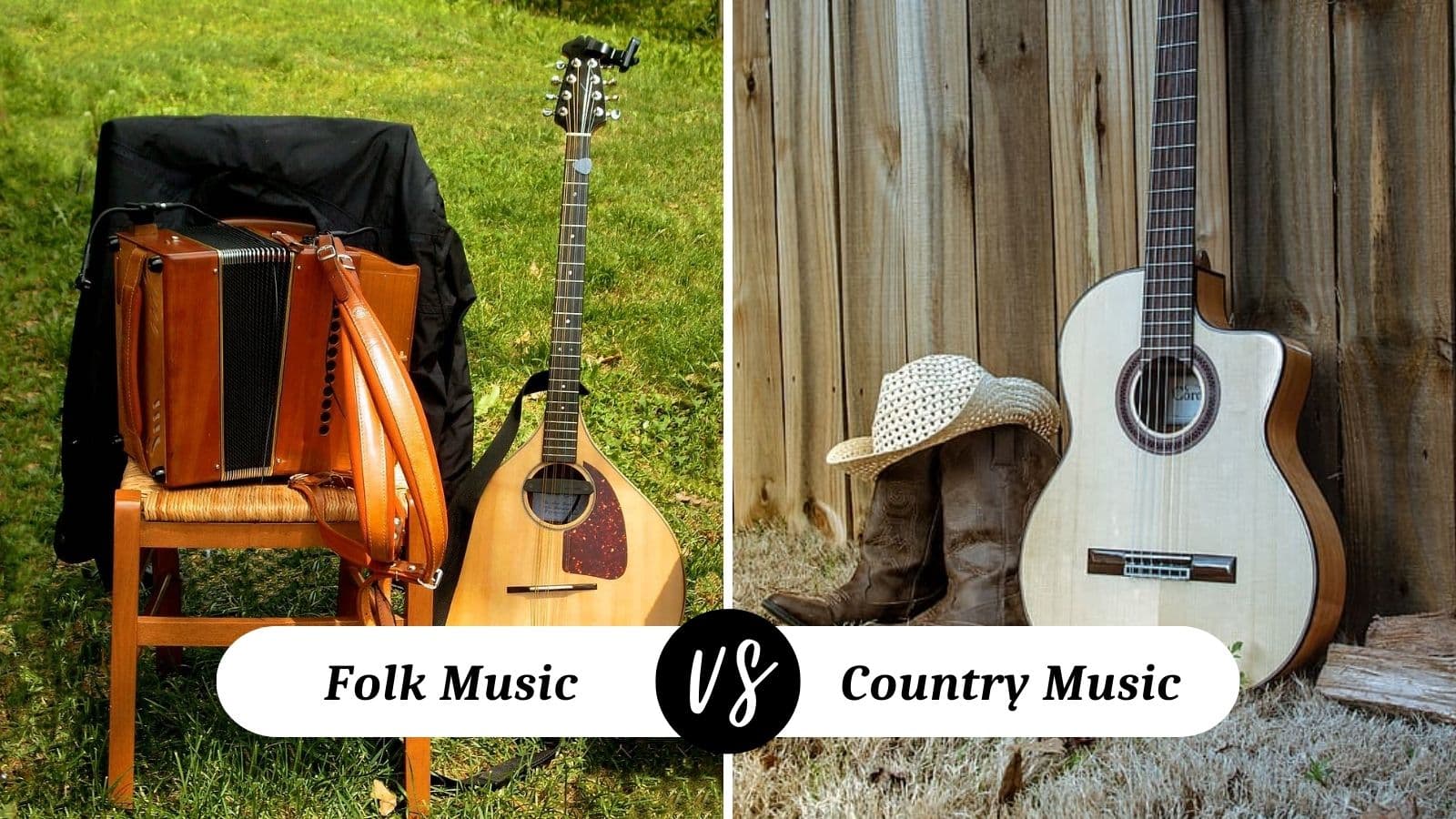
Folk music and country music can sound very much alike sometimes. However, the line between folk music and country music is sometimes very faint and not well-defined.
That doesn’t mean they are interchangeable terms. Although they share a common ancestry and particular traits, they are still two distinct and separate genres.
Definition the Genres
Let’s first start by looking at folk music and country individually below.
Folk Music is typically passed down from one generation to the next. The range of topics can be broad and include themes such as love, life, loss, and working conditions.
The music is simple so that anyone with or without musical training can join in making music on whatever instruments are available. Mostly acoustic guitars, banjos, and fiddles are present.
Differently expressed: folk music represents the culture of a specific subset of people. Folk music emphasizes preserving the stories and traditions of a community—some folk songs can even be traced back hundreds of years.
Singers frequently adapt these old songs to reflect their times while keeping their traditions alive. In comparison, folk music cannot pinpoint its exact origin because it constantly evolves with the community and times, country music and as we’ll see below.
We could take this description a step further. Rap music could be seen as folk music for (mainly) Black musicians (there are white rap musicians as well).
They tell the stories of their lived experiences, sometimes even referencing other artists (and bad-mouthing them) and songs. Genres such as trap music and its sub-genre, drill music, especially tell stories of inner-city decay, gang violence, and government apathy towards the plight of Black people.
Country music has a story to tell, but primarily it doesn’t involve protest. Often, simple ballads are heard, and Texas two-step or line-dancing tunes are prominent. Harmonies are relatively simple and rarely involve more than two or three voices. Country music also evolved from folk music.
The Bristol Sessions is generally agreed as the genesis of country music. Ralph Peer, a representative of the Victor Company, posted a notice on July 24, 1927, in the Bristol (Tennessee) News Bulletin.
The statement read: “The Victor Co. will have a recording machine in Bristol for ten days beginning Monday to record records — inquire at our store.” The Stonemans were a massive success with their hand-made instruments made by Ernest “Pop” Stoneman.
It should be noted that the Victor Company recorded traditional folk music. Still, it proved that the new ‘hillbilly music’ was marketable. Country music kept evolving from the Bristol Sessions as artists from the South started joining Victor Company with their variations on song forms.
Country music started developing a distinct sound and a move away from folk music. Folk music gave rise to country music, and Hank Williams, Sr. could be seen as the definitive archetype for country singers. At the same time, Woody Guthrie was the archetype for folk singers.
Folk Music vs Country Music
Both folk and country music share a common ancestor and heritage: the story-song tradition. However, folk stretches further back than country music, with melodies brought to America by English, Irish, and Scottish settlers.
Country music is a form of folk music, but folk music isn’t always country music.
The table below will investigate the similarities and differences between folk and country music.
| Folk Music and Country Music | |||
|---|---|---|---|
| Similarities | Origin | Rooted in the stories of the working-class/blue-collar working people Blends styles from English tunes and Scottish and Irish Celtic melodies Sea shanties from the United Kingdom, with railroad and cowboy songs from the US, often got merged into new songs --- many songs started as work songs |
|
| Rhythm | Simple rhythms that can be tapplapped, or even played with spoons. Audiences can also participate by clapping to the beat and following the rhythm Regular rhythms encourage audience participation |
||
| Instruments | Guitar, fiddle, upright bass, and mandolin are often heard and seen | ||
| Sound | Both genres have songs that tell stories, and a catchy chorus or phrase is repeated to engage audiences and tempt them to join in by singing along | ||
| Differences | Folk Music | Country Music | |
| Origins | Immigrants from the United Kingdom brought their music with them to the US | US Country developed from folk music | |
| Instruments | Folk groups may use whatever they have on hand---spoons, a washtub as a bass drum, or a washboard can be used to amplify rhythms | Electric and acoustic guitars can be heard Dobro, or resonator guitars, are often present Percussion instruments such as drum kits and the like are present |
|
| Themes | Nostalgic yearning for places and simpler times in songs like Shenandoah or My Old Kentucky Home Sometimes dealing with social justice issues. It can also deal with civil matters and protest | More introspective and person telling stories about the singer's life, losses and gains, love, etc. | |
| Sound | Takes on a regional flavor and sound Folk is more concerned with community involvement and giving people a voice Sounds more traditional because it is passed down through generations Sometimes folk artists find mainstream success, but they aren't as focused on this phenomenon | The Nashville sound started influencing singers and bands Corporate involvement drives sales and material to ensure mass appeal (artists can still deliver social commentary, and it isn't a taboo, just less common) Sounds modern, Nashville sound influences along with pop in more contemporary songs Contemporary folk is more like pop. Image is vital as record sales and mainstream success |
|
| Rhythm | The accompaniment is usually simple Usually, a light and easy-to-follow rhythm so that the community may join in | Richer, fuller sound, amplified instruments. Some artists even sing with full orchestras, e.g., Kenny Rodgers and Reba McIntire It can be driven by heavier drum parts, more pronounced bass |
|
| Song structure | Simple lyrics with easy to remember the chorus | Primarily ballads, songs can get intricate | |
Conclusion
Folk and country music are excellent for singers to tell stories about their lives and the conditions they lived through or found themselves in.
Folk music has no definitive beginning or end and is as rich and diverse as humanity. Country music emerged from folk music into an entire genre of its own.

